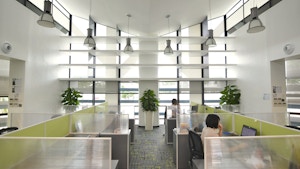With buildings and construction making up nearly 40 percent of all greenhouse gas emissions, greening them is key to limiting climate change. In November last year, Los Angeles, Mexico City, Budapest and Oslo pledged to halve their emissions from construction by 2030, while other cities have made greener buildings a central plank of their Covid-19 recovery plans.
In Singapore, the Singapore Green Building Council (SGBC) is getting stakeholders in the built environment sector on board too. Last November, it launched a course on sustainable supply chains for buildings, to encourage firms and organisations to address environmental gaps in their sourcing and reporting.
The one and a half day virtual course, slated to run once every quarter, is tailored for project managers, contractors, product manufacturers and suppliers, procurement specialists and other building professionals and consultants. Its topics include how to identify and limit sustainability risks in supply chains, integrate sustainability into procurement, and meet sustainability reporting requirements in Singapore and Southeast Asia.
Plan to progress
Esther An, chief sustainability officer for real estate firm City Developments Limited (CDL), said that setting targets, adopting standards and measuring progress is crucial.
The company, which helmed a session on green building strategies for the inaugural SGBC course, requires suppliers to be certified by specific international environmental, health and safety standards, such as the ISO 14001 standard that sets out criteria for an effective environmental management system.
CDL also has policies that promote the use of eco-friendly and recycled materials certified by approved local certification bodies such as the SGBC and green procurement guidelines for its properties.
“We recognise that a sizeable proportion of our carbon footprint lies outside of our business operations and direct control, so we actively engage our supply chains and stakeholders to mitigate their climate impact and add value to the communities that we operate in,” An said.
By partnering with companies and institutions, firms can also develop and pilot innovations for green buildings to plug gaps in the market, she added.
In the early 2000s, CDL worked with waste management firm Envac to pioneer a twin-chute pneumatic waste disposal system at a condominium in Singapore so that residents can recycle paper, plastic bottles, metal cans and other items more easily.
After a study trip organised by Singapore’s Building and Construction Authority in 2014, CDL also became the first property developer in Asia to use prefabricated prefinished volumetric construction (PPVC), a more sustainable approach to building where modules are completed off site before being delivered and installed on site.
“With CDL’s lead, PPVC has become a popular construction method mastered by many of our supply chain players. This is part of our long-term strategy for environmental and supply chain management, to invest in sustainable and more productive methods of building,” An said.
From financing to supply chains
Property firms also have greener options for every parts of their buildings. Besides installing water-saving taps, energy-saving lights, and smart building management systems to optimise operations, developers can cut their buildings’ embodied emissions by using sustainable materials for floors and walls.
Interface, a Singapore-based flooring company, offers carbon neutral floors, including carpet, vinyl and rubber tiles. “To shrink our products’ carbon footprint, we introduced more recycled and bio-based material, redesigned them to use less material, increased our energy efficiency and tapped on more renewable energy,” said Maxine Chen, formerly its sustainability communications specialist for Asia Pacific.
“After we reduced our products’ emissions to the lowest levels in our industry, it became economically viable for us to achieve carbon neutrality by purchasing a small amount of carbon offsets,” she said. The firm buys carbon offsets that are validated and verified according to international standards, and retired on third-party registries.
The offsets have come from solar, wind and hydro power projects in Mauritania, Thailand and China, reforestation efforts in the United States, Cambodia and Zimbabwe, and others. “For each flooring purchase, we calculate the estimated carbon reduction and present the documentation to the customer,” said Chen.
“We have sold over 379 million square metres of carbon neutral flooring globally, and retired about 5.3 million tonnes of verified emissions reductions credits,” she added.
Corrado Forcellati, director of sustainability services at accounting firm KPMG Singapore, said that developers could unlock more financing by investing in green buildings too. “We expect green loans and bonds to be increasingly used as financing mechanisms, as firms look to four ‘R’s – restart, rebuild, renew and recover – in response to Covid-19 crisis,” he said.
CDL has benefited from such loans and bonds. In 2019, for example, it secured a first-of-its-kind, $250 million loan from DBS Bank that includes a discount on the loan’s interest rate if it achieves sustainability-related performance targets on innovations that contribute to the United Nations’ Sustainable Development Goals.
“The increase in platforms and marketplaces to facilitate sustainable practices is also a clear indication that supply chains will become more transparent and business models will become more environmentally-friendly,” said Forcellati. He pointed to an upcoming platform, created by energy firms SP Group and Sembcorp Industries, that provides a marketplace for companies and consumers to trade renewable energy certificates and carbon credits.
The SGBC said that many players in the built environment industry have embraced sustainable supply chain management as they seek to manage risks and improve efficiency, and those that do not risk being left behind. There have also been requests for greater support in decarbonisation efforts so SGBC will be launching more programmes in the coming months to build capabilities.
It concluded: “With growing demands for transparency and reporting, organisations are also paying more attention to the sustainability of their partners and suppliers downstream, to address sustainability gaps and tighten sustainability policies.”
The next run of the SGBC Sustainable Supply Chain for Buildings course will take place on 18-19 May 2021. Visit the SGBC website to find out more about SGBC’s industry-specific events and training programmes.













